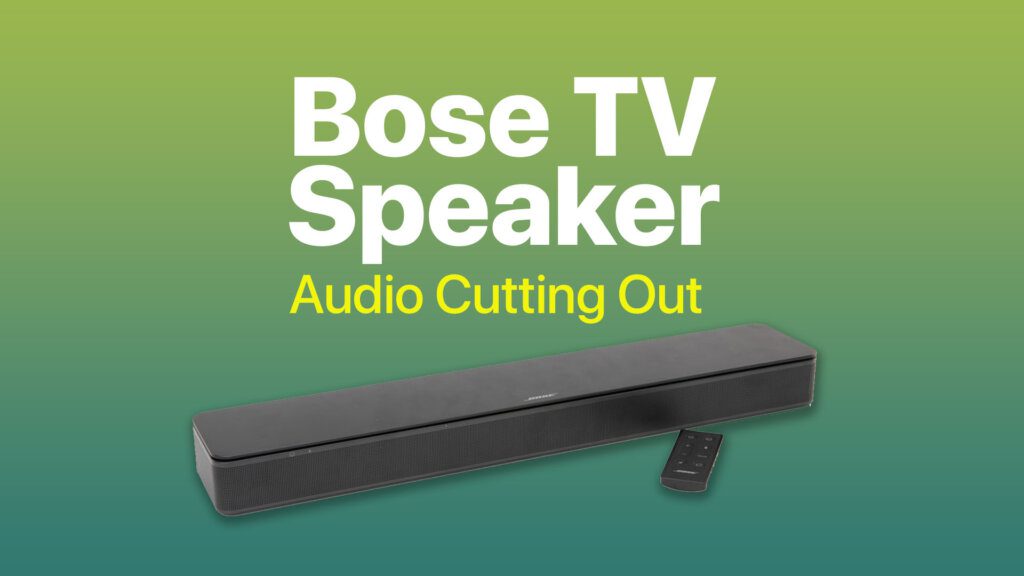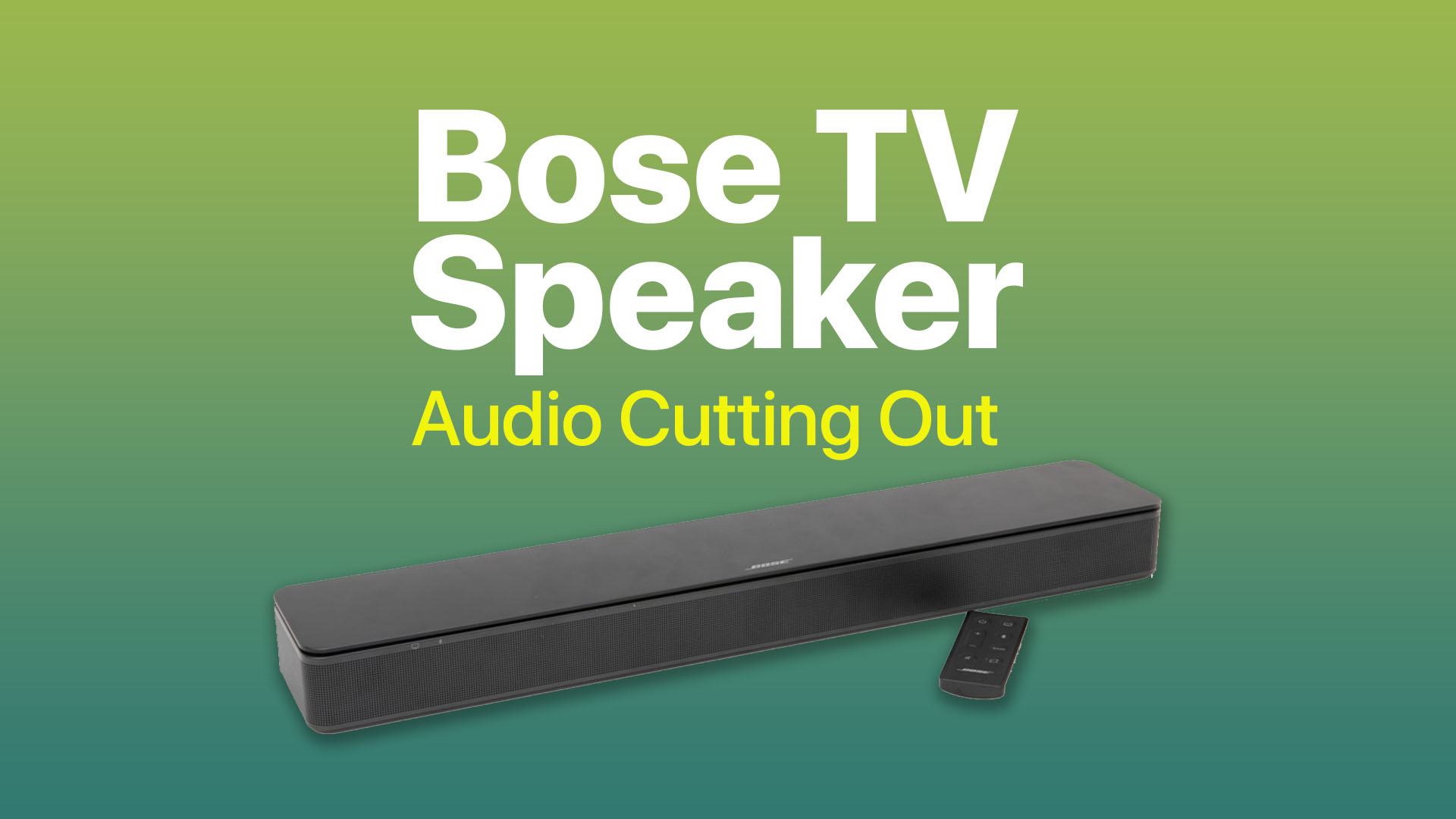Having issues with audio cutting out or sporadically dropping on your Bose TV speaker? This problem can be frustrating and disrupt your listening experience, but is usually caused by a handful of common technical culprits. With some targeted troubleshooting and adjustments, you can get your Bose speaker working properly again and prevent future audio dropout.

The most common reasons for a Bose TV speaker to have audio cutouts are interference from nearby electronics, connectivity problems with cables, incorrect audio settings on the TV itself, soundbar placement issues, and outdated software/firmware. Read on for steps to diagnose and correct each of these potential audio disruptors.
Common Causes:
- Interference from other devices. Nearby electronics like wireless routers, microwaves, baby monitors, cordless phones, and Bluetooth devices can create signal interference that disrupts audio.
- Faulty cables or loose connections. Damaged HDMI or optical audio cables, or cables not fully inserted, can cause connectivity issues.
- Wrong TV audio settings. Incorrect audio output settings on your TV prevents proper transmission to the Bose speaker.
- Placement and proximity problems. If the Bose speaker is too far from the TV or obstacles block the signal path, audio may cut out.
- Outdated firmware. Old software/firmware versions on the TV or speaker can create compatibility issues leading to audio dropout.
To troubleshoot and fix your Bose TV speaker’s audio cutting out, follow these steps:
Rule out and isolate interference from other electronics.
Radio frequency interference from other wireless devices in the vicinity can disrupt signal transmission between your TV and the Bose speaker, causing audio to sporadically cut out.
Turn off or unplug any electronics in the room like wireless routers, microwaves, baby monitors, cordless phones, Bluetooth speakers/headphones, or other TV peripherals. If the audio issue improves, you’ve identified the interference source. Keep the offending device turned off or move it farther from the TV and Bose speaker. If connected to the same electrical circuit, try plugging the TV and speaker into a different grounded outlet. Use ferrite choke cores on the power and audio cables to filter interference.
Inspect all cabling connections and swap out faulty cables.
Physical cable problems like damaged wires or loose plugs/ports are common causes of sporadic audio loss. Faulty HDMI or optical audio cables prevent proper transmission of sound to the Bose speaker.
Carefully inspect the physical condition of all cables connecting your TV to the Bose soundbar. Look for any kinks, worn insulation, cuts, or corrosion on the cable connectors. Ensure all plugs are inserted fully into ports on both ends. Snugly secure all cable connections. Try disconnecting and reconnecting cables to clear any loose fit issues. Swap out suspect cables to test with new high-speed HDMI or optical audio cables. Damaged cables must be replaced.
Adjust audio settings on the TV to enable and prioritize external speaker output.
Incorrect TV audio output configurations can override or disrupt signal transmission to your Bose speaker, causing dropouts. The TV speakers may be prioritized or turned on which interrupts routing audio exclusively through the Bose speaker.
Access the Audio Settings menu on your TV. Under Audio Output options, select External Speaker. Disable or turn the TV’s built-in speakers off. Enable digital audio output and Optical port if present. Choose Bitstream or Pass Through for audio encoding to pass unprocessed sound to the Bose speaker. Turn off CEC/ARC control if the option exists. Save these updated audio settings on the TV to keep your Bose speaker as the sole audio output priority.
Relocate the Bose speaker closer to the TV and optimize line-of-sight placement.
Positioning issues can interfere with wireless signal transmission between the TV and Bose speaker, so minimizing distance and obstructions is key for consistent audio.
Move your Bose TV speaker closer to the television, preferably within 5 feet and well within wireless range. Make sure the speaker is not isolated in an enclosed cabinet but positioned out in the open. Place it in direct line-of-sight with the TV, avoiding objects that may block signal like furniture or decor. Place the Bose speaker above ear level and angle it slightly downward toward the central seating area for optimal audio coverage. Test audio performance in the new location.
Update firmware and software on both TV and Bose speaker to current versions.
Outdated firmware is a prime suspect for connectivity issues. Old firmware versions can lose compatibility with new TV software and HDMI/audio standards. This disrupts communication between TV and speaker.
On both your television and Bose TV speaker, check settings for current firmware installed. Consult the manuals or manufacturer websites for instructions on forcing firmware checks, downloading, and installing the newest updates. Keep the TV and Bose speaker firmware regularly updated to maintain compatibility. Consider resetting devices to factory defaults after major updates.
By methodically addressing these common underlying causes, you can troubleshoot why your Bose TV speaker is having audio cutouts and static and resolve the problem. Interference, cabling faults, incorrect settings, placement, and outdated firmware are usually the culprits behind such audio disruption. Carefully inspecting connections, optimizing placement, and updating firmware will have your Bose speaker reliably sounding great again. Just take it step-by-step until audio plays consistently without frustrating drops.
